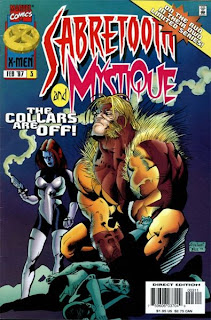 The Old Way
The Old Way Credits: Ben Raab (writer), Salvador Larroca (penciler), Scott Koblish (inker), Kevin Tinsley & GCW (colors), Richard Starkings & Comicraft (letters)
Summary: Colossus bumps into Amanda Sefton as she abruptly leaves Muir Island. She mysteriously refuses to say goodbye to Nightcrawler. Peter Wisdom receives a message from a “Peckham,” which upsets him. Meanwhile in London, Brian Braddock is attacked by the Dragons of the Crimson Dawn. Meggan is briefly knocked unconscious during the fight, but comes to and rescues Braddock when one of the Dragons drops him from the sky. Spiral tries to sneak away, but is warned by the Dragons that she still has work to do. The Dragons teleport away with Braddock, leaving Meggan to ask Spiral for help.
Continuity Notes: Shadowcat and Wolfsbane travel to Dublin for a brief vacation. They visit the world famous hairdresser Molly Fitzgerald, who is secretly the hero Shamrock. She’s using crutches, which she claims she needs after slipping in “the loo.” The story doesn’t identify her as Shamrock, and the letters page essentially dares the readers to identify who she’s supposed to be.
The Dragons of the Crimson Dawn consist of Ra’al (the female leader with a deadly kiss), Barak (the big strong man who can grow larger), and the flier, A’Yin.
Review: The storylines keep moving, albeit slowly. The main goal of this issue is to introduce the Dragons of the Crimson Dawn with a lengthy fight scene. Unfortunately, Larroca’s storytelling isn’t really able to create a truly energetic fight at this point. Plus, the villains are all otherworldly mystic characters with vague motivations, so it’s hard to care that much this early on. All of this is standard team comic material, as the hero loses the first round of the fight before the rest of the team is brought in, while a few subplots involving the remaining cast build in the background. Nothing really stands out as good or bad, but I am slightly intrigued by the Shamrock cameo. I can’t imagine the character showing up for anything other than camp appeal or comedic relief, but I wonder why Raab saw fit to put her in crutches. That just has to be a setup for something in the future, because surely no one would go out their way to establish such a minor character was injured without having some justification. And “slipping in the bathroom” just stands out as a rather obvious lie.

Dragon Moon Rising
Credits: Ben Raab (writer), Salvador Larroca (penciler), Scott Koblish (inker), Kevin Tinsley & GCW (colors), Richard Starkings & Comicraft (letters)
Summary: Spiral arrives at Muir Island with Meggan, and is promptly attacked by Excalibur. When Meggan eventually recovers from the disorienting effects of Spiral’s teleportation, she explains to the team that Spiral is actually helping her. Spiral claims that she came across the Dragons while exploring the mystical Wildways. The Dragons used their superior magic to draw Spiral to their side, forcing her to locate Psylocke’s more powerful brother, Brian Braddock. Meanwhile in Hong Kong, Braddock awakes. After he fails to defend himself, Ra’al enters Braddock’s mind.
Review: So, what’s accomplished this issue? We learn the reason why Spiral joined the Dragons of the Crimson Dawn, although the story acknowledges that she isn’t the most reliable source on Earth. (And if their magic is so much more powerful than hers, why do they need her to find Brian Braddock in the first place?) The team then leaves with Spiral to locate Captain Britain, which only advances the plot one millimeter since the last issue ended with Spiral and Meggan leaving to recruit Excalibur. I guess if you really wanted to see Excalibur fight Spiral for several pages, there’s plenty of action here to entertain you, but the main story is dragging. This is also the second issue in a row that has Meggan conveniently knocked unconscious for most of the story, which is a cheat if you consider that she’s supposed to be the most powerful member of the team. I do like the way Raab is tying the Crimson Dawn into the other mystical realms of the Marvel Universe, such as the “Wildways” introduced in the Longshot miniseries, but I wish the pace wasn’t so slow.




























